Rudy Gobert - Center of Attention
Rudy Gobert is perhaps the most underrated player today. In a hyperscoring NBA world where there have never been so many players with 20 or more points per game, Gobert with his 2.16 meters (7ft 1) and Pterodactyl-like wing-span of 2.36 meters (7ft 9) has only 14.4 points per game. But does that even matter at all? Because Gobert’s influence on the Jazz’ defense and offense can be seen in some “unconventional” statistics that are simply impressive.
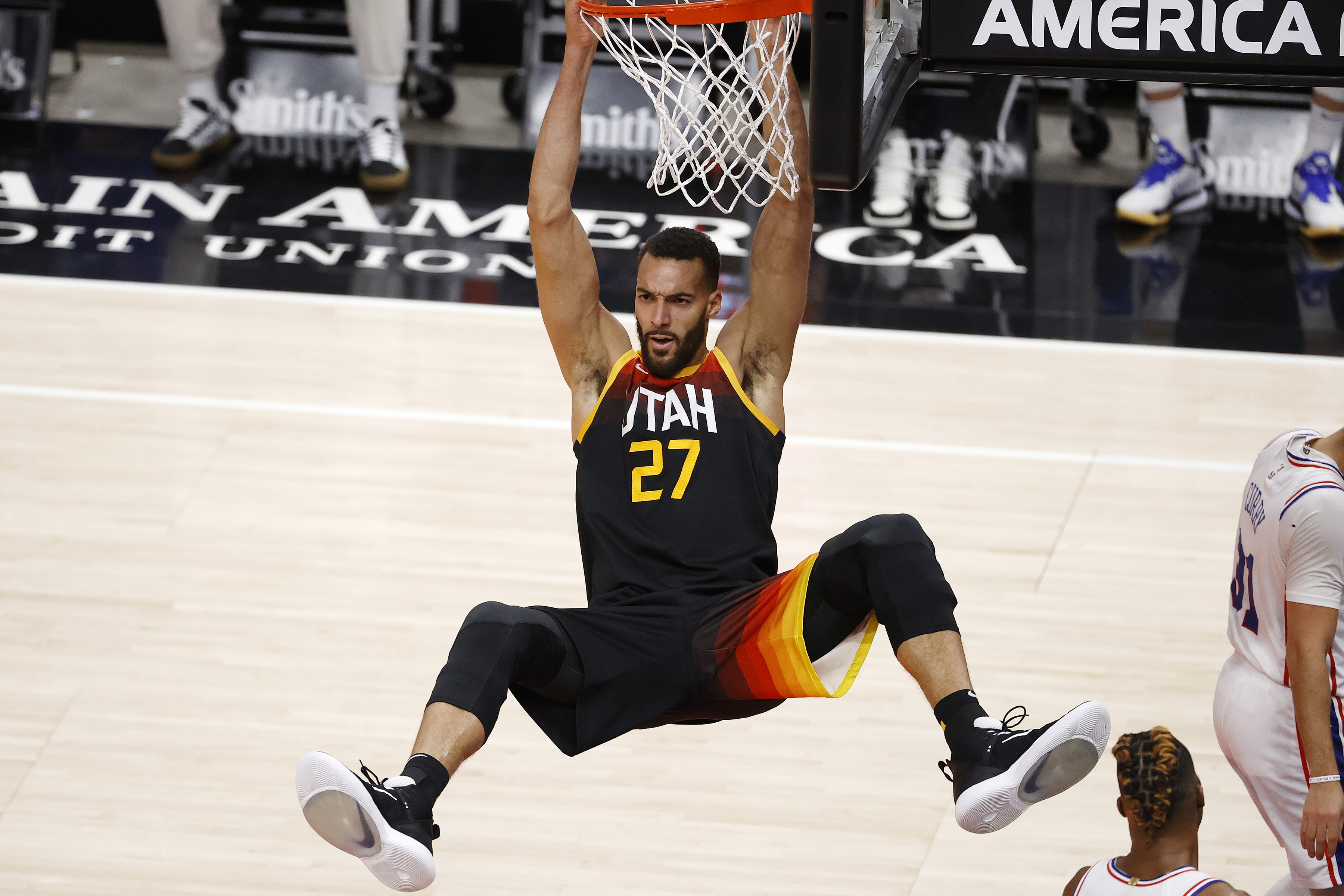 Credit: Jeffrey Swinger-USA TODAY Sports
Credit: Jeffrey Swinger-USA TODAY Sports
We can say that Gobert is the undisputed champion of the entire NBA league in defense. So we’ll break that down first.
The Stifle Tower
This nickname is actually very appropriate (like the Joker for Jokić). The main reason are, of course, Gobert’s blocks, he is second in the league in blocks per game, with 2.9 per game, which is also the highest number in his career. In addition, his “defensive chat”, as I like to call it, looks impressive.
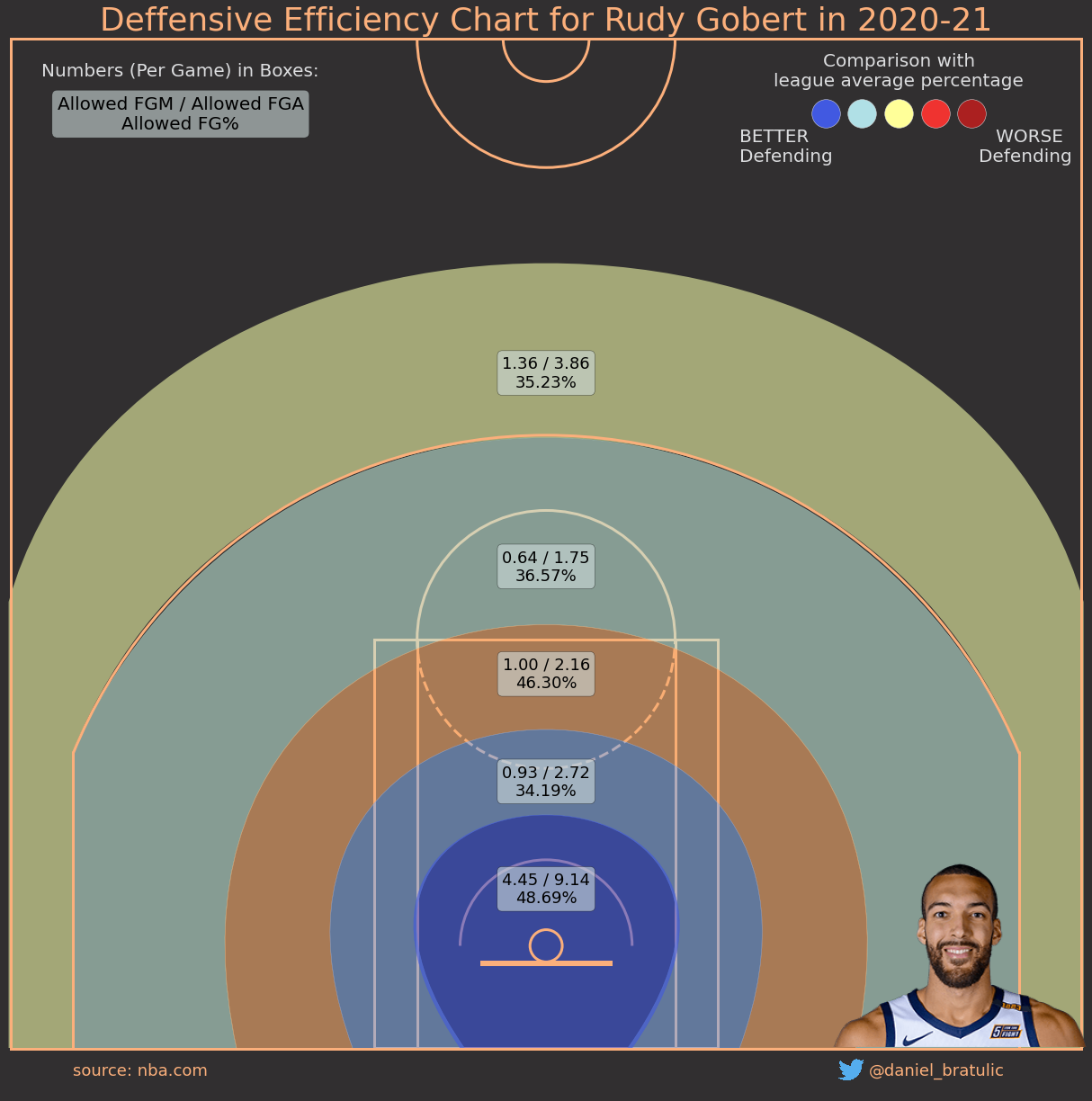
Rudy defends a total of 9.3 shots per game in the area <1.8 meters (6 ft) from the hoop, which is the 2nd highest number in the entire league just behind Myles Turner. And him, Turner and Poeltl are tied for the lowest shot percentage they allow (among people that allow a respectable number of defended shots). He’s also good at defending other shots in the paint and around FT line, but the area near the rim is definitely the most important. We won’t even consider the three pointers in his case, because those are usually just (late) closeouts on shooters who are open, and in those situations Rudy might not even be that close but he’d be attributed with defending a shot because he’s the nearest to a shooter.
Ability to deter players from the rim
What’s actually even more important than how much and how effectively Gobert defends the shots at the rim is how many he doesn’t actually have to defend? That is, how many shots opposing players take from a short or long mid-range due to his very presence in the paint.
“Rudy doesn’t only protects rim, he deters players from them.” Those words were said by Zach Lowe in one of his podcasts and since then I wanted to write something more detailed about Rudy.
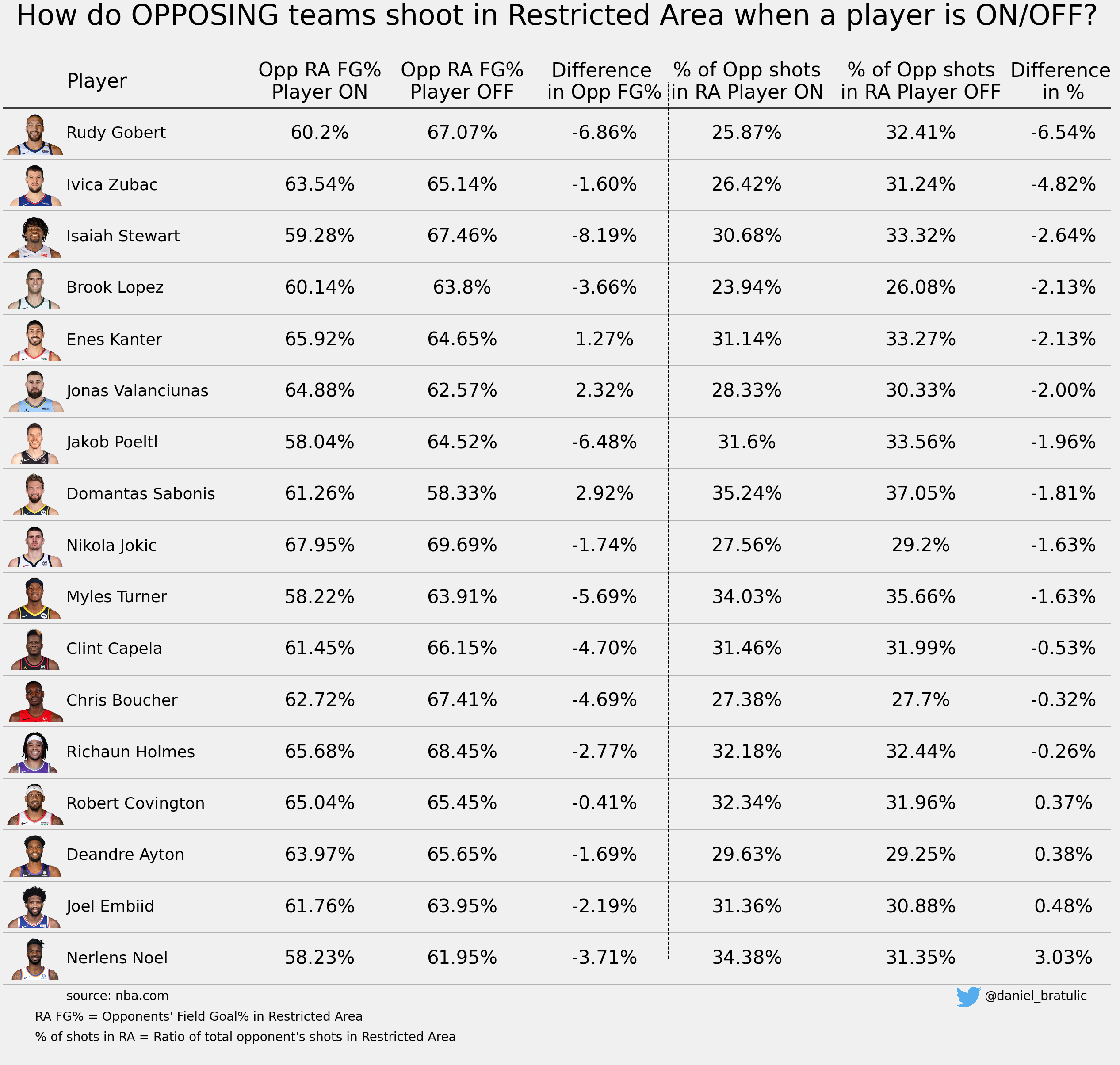
This table shows the players who defend the most shots in the entire league and how the shot distribution and the efficiency of the opposing teams looks like when they are ON/OFF of the floor. So not only directly defended shots are taken into account here, but ALL those shot by the opponent.
The last column is the most interesting, when Gobert is off the floor opponents shoot 6% more often from Restricted Area! This is by far the largest number of all these players. In addition to affecting the number of shots from RA, he is one of the best in terms of reducing the effectiveness of opponents’ shots.
It’s interesting that the Jazz are somewhere in the middle of the table of all teams in the number of shots allowed from the restricted Area (26 per game) -> this further emphasizes the difference in defense quality when Rudy is on the floor and when he plays, because Bucks, Suns, Mavs but even the Nets have on average fewer allowed shots from the Restricted Area.
For me personally, this information is fascinating, and it shows how important Gobert is for the Utah team, that is, how they build the whole defensive scheme towards him and are depending on him.
Where are Jazz opponents’ shots located why is that?
The question that arises after all that has been said is where exactly do Jazz’ opponents shoot from? You can see that in the following table.
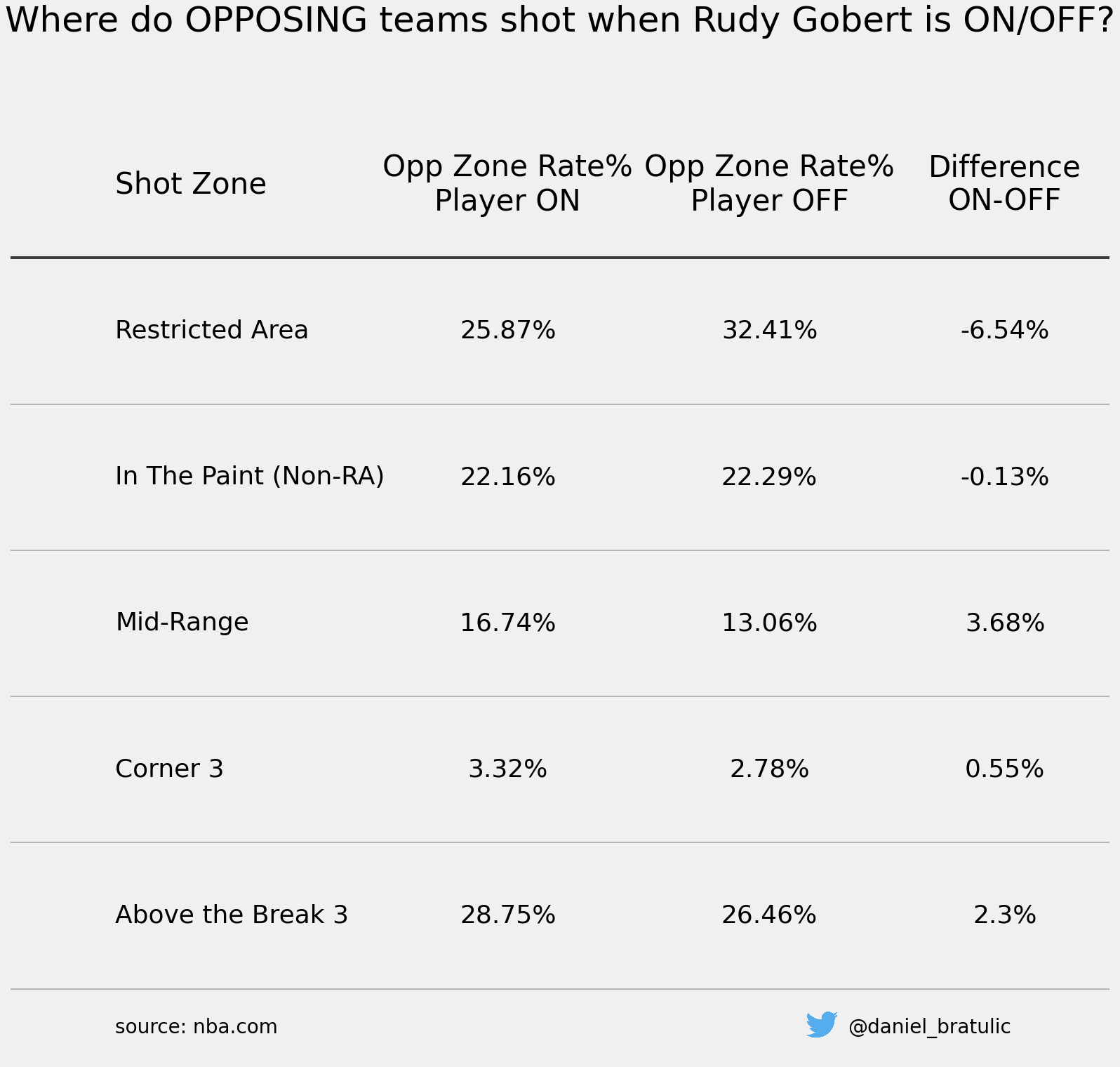
The players shoot a lot more in the mid-range, as they can’t get to the basket because Gobert is waiting for them in the paint. Simply his presence under the rim forces the players to take a shot from mid-range, from where they might not otherwise shoot. Another area that has a slightly bigger jump is Above The Break triple, which is logical since Gobert mostly plays in a deep drop during pick and roll.
Deep drop
Deep drop is a way of defending pick and roll in which the center does not switch on the player handling the ball but stands deep in his paint, and the defensive player on the ball handler usually fights over the screen. Such a defense is a great solution against good roll big-men and point guards who are not excellent shooters. Gobert is dominant in such a game as he manages to laterally cover both players within the pick and roll due to height and speed.
You can see an example of such a defense against Morant, who is a classic example of a player against whom a deep drop is played as he’s shooting only around 30% from 3 pointer.
Aggressive drop
The second type of drop is an aggressive drop in which the player does not stand completely in the paint but is much closer to the player setting the screen and he’s trying to obstruct the player with the ball immediately after the screen. As mentioned earlier, Rudy has good lateral quickness and can play such drop when needed (against Steph, Dame and similar players). This is a segment of the game in which he is much better than some other “classic” tall players and the reason why he is scary in the pick and roll game. Here are a few clips in which Gobert effectively defends from an aggressive drop.
In the first clip he defends Lillard and takes away his three, Lillard manages to drive to the hoop but Gobert follows him well and forces a missed shot, in the second one he “bites” on Steph’s fake, but manages to recover and block the shot.
1-on-1 defense
Of course they won’t put Rudy on Steph or Dame, but in situations where a switch happens Gobert can cover faster guards, especially when they drive to the basket.
As I mentioned before, he’s incredibly agile for such a tall player, and that’s something that sets him apart from other drop centers (e.g. Adebayo, Claxton and Robert Williams III are not droppers, as they very often switch on defense, also Adebayo and Williams are significantly shorter than Gobert, more than 10 cm - 4 inches). And even if they manage to beat Rudy on the first step, the huge wingspan helps to either contest or block the shot.
But not everything is wonderful…
How to attack Gobert then?
So even though he is extremely mobile for such a big center, he still is a center… He will not always be able to keep up with such excellent guards who are agile and mobile. I even think that he has a bigger problem defending players who tend to dance on the three point line more than in situations when they drive to the hoop.
Gobert can be too aggressive sometimes on defense, and tries to guess the direction of movement of the player with the ball, very often this can fail in the way that the ball handler rejects the block and moves in the other direction. In addition, we have Steph who dances around the 3-pt line, but realistically thera are very few players in the league that can perform something like that. Rudy mostly struggles when the so-called high screens are played, which are closer to the center than the three-point line, then players with the ball have more room to maneuver to catch him on the wrong foot and pull up for the shot, or drive to the basket.
However the best weapon in attacking Gobert is through a three-pointer, and those three-pointers mostly come from tall players. Opposing teams attack him through either pick and pop when both Gobert and the defender have all their attention on the ball handle, or place a player that Rudy defends in the corner and rely on his three-pointer skills. And that now raises a question of whether Gobert is capable of playing in playoff games and that’s one of the biggest reasons why a lot of people don’t look at Utah as serious contenders for the title. But I’m kind of optimistic about it, I think he’s a lot more valuable with his help defense in those situations than defending that one tall three-point shooter in the corner, but that’s the risk the Jazz need to take every time, because those players that Gobert should defends in such situations often aren’t quality shooters who can punish such situations possession in and out.
And lastly, one perhaps a little unrelated thing, but when it comes to annual awards, we should not to think about how Gobert will play in the playoffs, but how he played at the level of the whole season, and he is by far the best player through the regular season.
Gobert as the initiator of the Utah’s offense
I hope I’ve convinced you through the previous few excerpts of how good of a defensive player Gobert really is (if you had to be convinced at all), I’ll now try to do the same for the offensive side. But this is a slightly more difficult task.
Namely, Gobert simply does not have the right basketball/technical abilities to be a serious offensive center. He has only couple of possessions per game in the post ups, which is perhaps good because he is terrible in scoring from them - only 0.46 points per possession, which is one of the worst ranks in the league.
Where he shines are pick and roll actions and putbacks. Thus, here is a chart showing Gobert’s efficiency in those plays.
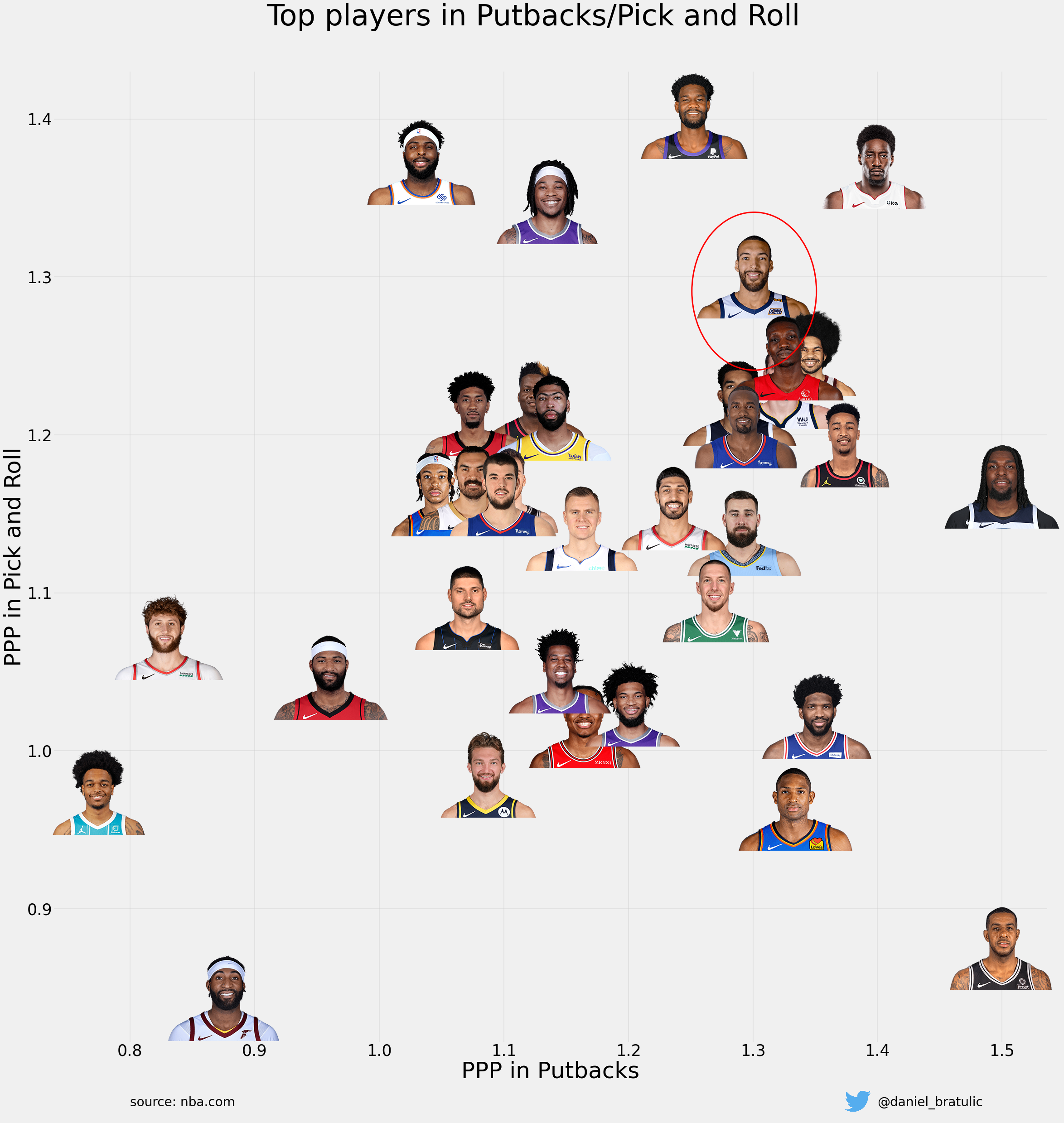
He is at the top of the league in both actions and only some elite rollers like Ayton, Holmes, Adebayo and Robinson, who is an Alley-Oop machine, are better than him in pick and roll.
Pick and roll
In addition to being excellent at scoring from such situations, Gobert greatly helps Mitchell and Conley in creating and scoring with his amazing screens. After all, he is the first in the league in screen assists.
Along with screen assists, there is another extremely important element of the game in which he is among the best in league, and that is how much his very presence in the offense requires the attention of opposing players. There is a simple expression for the previous sentence - gravity. And the gravity around Gobert when rolling towards the basket is extremely strong.
From these previous few clips, you can see how players on the weak/strong side have to get in the paint to help their centers when Gobert is rolling. In extreme situations when the switch defense is played (as in the clip against Boston) this is especially noticeable. Jazz shooters like Bojan, Ingles and Clarkson benefit the most from this as they’re usually wide open in the corners. Utah is first in the league in the number of shots from corners, with 1 shot more per game than second-placed Clippers, and that area is generally the most efficient after the restricted area.
Conclusion
In my humble opinion, but also according to many advanced statistics, Rudy Gobert is the most important player of Jazz because both the offensive and defensive game is built around him. Often his impact is hard to describe with classical numbers.
But a few days ago, they played two games against the Lakers. In the first one, in which Gobert did not participate, they lost in overtime, and the main problem was that they allowed as many as 64 points from the paint. In the second game, in which Gobert played, the Lakers were left with only 36 points from the paint, almost twice less…
He is, like Jokić, the player with whom the whole story of Jazz begins and ends.
